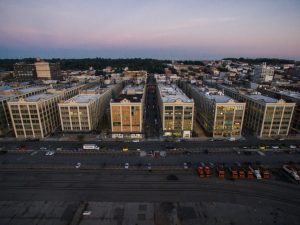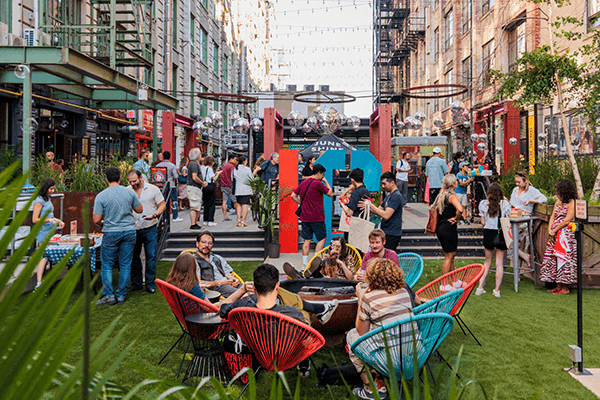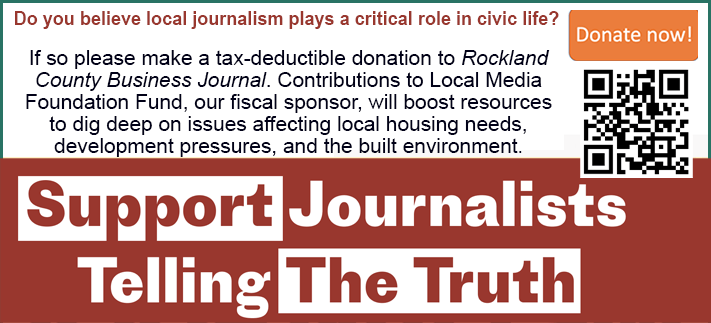|
RCBJ-Audible (Listen For Free)
|
Rockland Is Filled With Old Buildings And Vacant Campuses That Could Be Transformed Into Successful Redevelopments
By Tina Traster
On a recent Saturday, I drove an hour from Rockland County to a pop-up home design show held at Brooklyn’s Industry City. The design show was meh; the real thrill was the discovery of a decade-long industrial redevelopment project that has brought a winning combination of industry, office and makers’ space, co-working, retail, food halls, and entertainment to Brooklyn’s Sunset Park waterfront neighborhood.
I spent the day weaving in and out of the alluring complex with a goody bag’s worth of amusement and delight but as I headed back to our greener pastures, I found myself wondering why we can’t do more with the large, often fallow campuses in our county that have sat idle for years or are giving way to warehouse development.
Sure Industry City is in Brooklyn, and Brooklyn is, well Brooklyn, but it sets an example. Industry City is a former manufacturing site that has been transformed into a working hub, a destination, a magnet for pedestrian traffic and tourism, an example of taking something historic and making it relevant again. I’m thinking about the former Pfizer campus in Pearl River, the Garner Arts Complex in Garnerville, the Letchworth campus in both Haverstraw and Stony Point. Even the HNA Palisades Training Center on Route 9W in Orangetown.
If you were hovering above like a drone over Industry City, you’d see rows of long symmetrical buildings lined up like Legos on one side and the Upper New York Bay on the other. But on the ground, the sterility gives way to a cool, hip vibe, because the streets are cobbled stones, the buildings are interconnected and there’s appointed outdoor space that serves as hubs for gathering.

The 6-million-square-foot business park on 35 acres in the Sunset Park neighborhood of Brooklyn has eight massive buildings, between 33rd and 37th Streets and 2nd and 3rd Avenues, filled with offices, studios, and light manufacturing space for more than 550 companies.
It’s not exactly a “waterfront” attraction, but near enough. From the windows of abc carpets you have a clear view of the Statue of Liberty.
A consortium composed of Belvedere Capital Real Estate Partners, Jamestown Properties, and Angelo, Gordon & Co., purchased Industry City in 2013. The group envisioned “a hotbed for innovation, collaboration, and community that’s reinventing urban manufacturing for the 21st century.” We see phrases like this a lot from developers, planners, and town officials but it takes vision, deep pockets, and perseverance to pull off an adaptive reuse at this scale.
Adaptive reuse is the repurposing of buildings that have outlived their original purpose. Its main goals include preserving architectural and cultural heritage, transforming blight, igniting social change, preserving and expanding tax rolls.
Industry City, once known as Bush Terminal, stretches back to the late 1800s when the first warehouses were built by the water. During World War I, the US Navy took over the area and the Brooklyn shipping and storage facility served as America’s primary ammunition, food, and clothing depot. In 1956, what may be the largest explosion in NYC history rocked the terminal: A blast at the Luckenbach Steamship Company pier “launched steel beams half a mile, rattled buildings in Lower Manhattan and could be heard 35 miles away,” according to the New York Times. By the 1970s and 1980s, much of the complex was abandoned.
Industry City Is A City Within A City
Called “a city within a city,” the campus has become a hub for media, creatives, entrepreneurs, incubators, manufacturing, fabrication labs, film production, content studios – the very vision the Hudson Valley iCampus (the former Pfizer campus) had at one time hoped for, though its 2 million square foot campus remains largely vacant. The type of energy and synergy that has unfolded at Industry City calls to mind the potential bones and infrastructure at the Garner Arts Center.
Rockland County’s Untapped Potential
One might argue Rockland County doesn’t have the critical masses or transportation infrastructure to pull off a feat like Industry City. I remain skeptical about those purported obstacles. Rockland County is well situated to draw folks from New Jersey, Westchester, and Orange County, and of course New York City. Our County Executive Ed Day constantly bangs on about the value of tourism to the county, and has an executive assigned to the task. The genius of Industry City is that its base layer is an everyday workforce but its jewels in the crown are the add-ons and versatility that make it fertile for tourism and foot traffic.
The campus has an ice-skating rink in winter, miniature golf in summer, bars, distilleries, an escape room, an indoor pitch at Petanque by Carreau Club, to name a few. Nazz Forge in Building 6 offers classes on age-old trades as blacksmithing, knife-making, and leather-making. Visitors wend in and out of the buildings through outdoor covered areas where you can sit, eat, people watch, listen to music, and attend year-round events on five acres of outdoor space with heating, furniture, and fire pits.
The campus has a collection of some of New York City’s best food vendors and markets, with two food halls.
Industry City’s “Design District” is drawing both name brand retailers and artisans, including Porcelanosa, Design Within Reach Outlet, RH Outlet, Shakuff Lighting, abc carpet & home outlet, IC Store by WantedDesign, vintage furniture and artifacts retailer CityFoundry, and block textile brand Soil To Studio, among others.
DUMBO’s iconic Powerhouse Books has an expansive outpost in Building 3, featuring a well-curated selection of interesting titles.
Industry is attracted to the multi-use complex for its assets including high ceilings, abundant light, and oversized elevators. With the addition of dark fiber cabling, landscaped outdoor space, and the potential to raise roofs, remove columns, and divide floors, they’re suitable for production, at any scale. The buildings’ narrow floor plates bring in natural light, accommodate single floor tenants up to 25,000 square feet, allow for divisions down to 3,000 square feet, and provide flexibility for open plan creative offices, maker spaces, or content studios.
NYU’s Tisch School of the Arts recently signed a long-term deal to open the Martin Scorsese Virtual Production Center in Building 8 of the Sunset Park campus. New York University’s new film production facility plans to take 45,586 square feet of space.
The Scorsese Center joins more than 70 other film- and media-related businesses, where rents as of November 2022 ranged from $15 to $40 per square foot.
A medical lab specializing in immunotherapy, American Outcomes Management, recently inked a seven-year lease for 13,614 square feet in Building 6 for somewhere between $38 and $45 per square foot. Nearly 38,000 square feet of retail and design space has been snapped up by West Elm’s outlet store, Kohler, and Hilti, in Building 1.
Sunset Park-based biotech firm Aanika BioSciences is ramping up its footprint in Industry City. The company, which uses genetic engineering to underwrite insurance policies on food items, is growing its facility by 23,500 square feet while expanding its headcount.
Industry City is a fun day out for just about anyone but its also a palate of inspiration for those who have the reins on re-development sites in suburbia. Go take a look!














